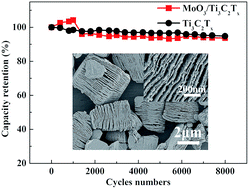Synthesis of a MoO3/Ti3C2Tx composite with enhanced capacitive performance for supercapacitors†
Abstract
In this work, a composite of molybdenum trioxide (MoO3) nanoparticles anchored on two-dimensional layers titanium carbide (Ti3C2Tx) has been successfully synthesized via a facile hydrothermal process. MoO3 was introduced to improve the contact region between electrode and electrolyte to shorten the paths of ion migration and intercalation. Ti3C2Tx has been integrated to act as a supporter to prevent the self-aggregation of MoO3 combined with the charge transport channel and high conductivity donor to the composite. The structure and morphology of the MoO3/Ti3C2Tx composite were characterized by X-ray diffraction, nitrogen adsorption–desorption, scanning electron microscopy (SEM) and transmission electron microscopy (TEM). Cyclic voltammetry tests showed that the MoO3/Ti3C2Tx (III) composite exhibited a maximum specific capacitance of 151 F g−1 at a scan rate of 2 mV s−1, which is higher than that of pure Ti3C2Tx (103 F g−1). Furthermore, the composite displays an excellent cycling stability with 93.7% specific capacitance retention after 8000 cycles at 1 A g−1.


 Please wait while we load your content...
Please wait while we load your content...